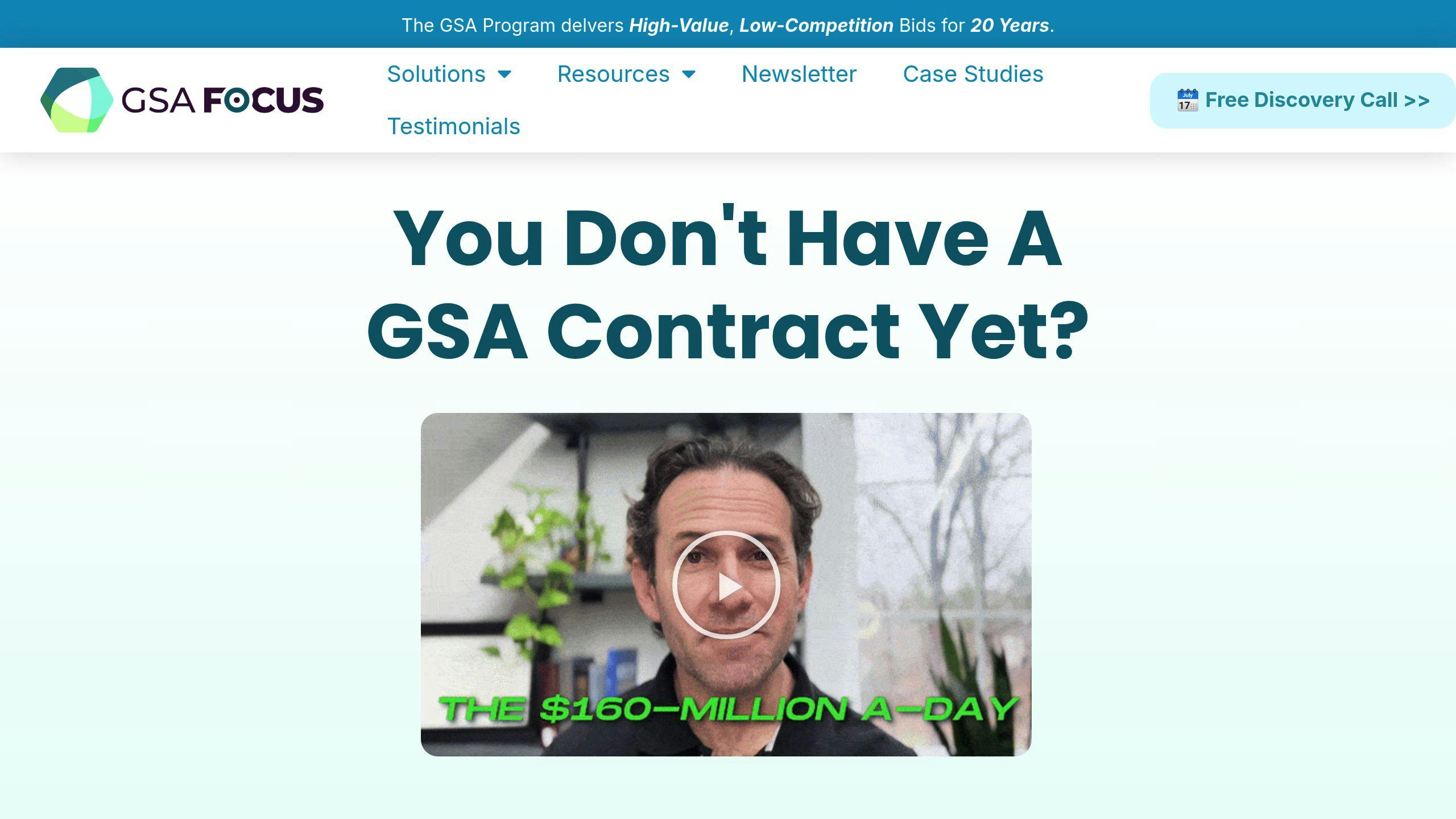Want to secure a GSA contract? Here’s what you need to know upfront:
-
Main Goals of GSA Negotiations:
- Fair Pricing: Offer the government your best rates, matching or beating commercial terms.
- Compliance: Follow all federal rules and provide complete documentation.
- Value Delivery: Prove your offerings meet government needs effectively.
-
Key Pricing Rules:
- Most Favored Customer (MFC): Match the best pricing you offer to commercial clients.
- Supporting Evidence: Submit past invoices, catalogs, and detailed pricing structures.
- Adjustments: Prices can be updated after 12 months, up to three times yearly.
-
Preparation Steps:
- Research Tools: Use FPDS, GSA Advantage, and GSA CALC for market insights.
- Analyze Data: Review sales records, discounts, and market comparisons.
- Plan Strategy: Focus on pricing, market position, and negotiation flexibility.
-
Post-Negotiation Compliance:
- Price Reduction Rule: Match GSA prices if better terms are offered commercially.
- Reporting: Submit monthly sales data and pay the 0.75% Industrial Funding Fee (IFF).
Pro Tip: Tools like GSA Advantage and expert services like GSA Focus can simplify the process, especially for small businesses. Ready to dive into the details? Keep reading.
GSA Pricing Analysis
GSA Pricing Requirements
Understanding GSA pricing rules is key to navigating contract negotiations successfully. These standards ensure that taxpayer money is spent wisely while contractors receive fair compensation.
Most Favored Customer Pricing Rules
The Most Favored Customer (MFC) pricing rule is at the heart of GSA’s pricing policies. This rule requires contractors to offer the government prices that are equal to or better than what their best commercial customers receive under similar terms.
To comply with MFC rules, contractors need to:
- Submit CSP documentation: Include pricing structures, discounts, and terms for all customer types.
- Match or beat commercial rates: Ensure government pricing is on par with or better than your best commercial offers.
- Provide supporting evidence: Submit past invoices and catalogs to back up your pricing claims.
- Maintain consistent practices: Keep your pricing steady throughout the contract duration.
GSA also considers the overall value of your offerings, not just the price.
"Pricing is arguably one of the most important parts of your company’s GSA Schedule." – Winvale Consultants
Price and Value Requirements
When reviewing contract proposals, GSA looks at both pricing and the value your products or services provide. They evaluate whether prices are "fair and reasonable" based on several factors.
| Evaluation Factor | Details |
|---|---|
| Labor Rates | Assessed by job functions, required education, and experience levels |
| Training Services | Evaluated based on course content, duration, and delivery method |
| Products | Considered by description, quantity, and delivery terms |
| Market Position | Compared with similar contractors in the industry |
Contractors can modify prices after the first 12 months, up to three times per year. Adjustments must align with commercial price changes, fixed escalation rates, or market trends.
To make compliance easier, you can join the Transactional Data Reporting (TDR) program. This program:
- Removes the need for detailed CSP disclosures.
- Requires reporting of sales data to help GSA track pricing trends.
- Simplifies the negotiation process.
Tools like GSA Advantage! and the GSA Calc Tool can help you stay competitive. Remember to update your electronic price list within 30 days of any approved price changes.
Steps Before Negotiations
According to FPDS data, businesses that prepare thoroughly before entering negotiations are 73% more likely to secure better contract terms. This highlights how crucial pre-negotiation planning is for success.
Research Federal Markets
Use key federal market research tools to gather insights that can shape your negotiation strategy:
| Tool | Purpose |
|---|---|
| FPDS | Analyze past contract values and buying patterns |
| GSA Advantage | Review competitor pricing and offerings |
| SSQ+ | Monitor sales trends and pricing |
| GSA CALC | Compare current market labor rates |
This research ensures your pricing complies with MFC rules while helping you stay competitive in the federal marketplace.
Analyze Data and Plan Your Strategy
Review Sales Data
Take a close look at your commercial price lists, government sales records, customer discounts, and market comparisons. This step ensures your pricing meets the "fair and reasonable" standard under FAR Part 15. Use the MFC pricing patterns detailed in GSA’s pricing guidelines to stay aligned.
Develop Your Negotiation Strategy
Your strategy should focus on these key areas:
- Pricing Structure: Break down your commercial pricing in detail and back it up with documentation.
- Market Position: Highlight what sets your offering apart and justify your pricing with market data.
- Concession Strategy: Pinpoint areas where you’re willing to be flexible, but balance this with long-term profitability. Consider Economic Price Adjustment (EPA) allowances, which allow price increases up to 10% under certain conditions.
"The Pricing Section is the final and most complex section of the GSA Proposal, where you must set out your prices and price justification." [2]
sbb-itb-8737801
Steps During Negotiations
Navigating GSA negotiations requires careful planning and a clear strategy. Building on your pre-negotiation groundwork, here’s how to tackle the active negotiation phase.
Submit Your First Offer
Your first offer lays the groundwork for the entire negotiation process. Pay close attention to these key elements:
| Component | Required Elements | Tips |
|---|---|---|
| Pricing Documentation | Commercial price lists, discounts, market data | Provide a detailed cost breakdown with evidence to back it up |
| Value Proposition | Unique features, past performance, capabilities | Highlight what sets you apart from competitors |
| Technical Response | Product/service specifications, compliance docs | Ensure everything aligns with GSA standards |
When submitting through GSA eOffer, make sure to assign authorized negotiators with signature authority. This will help streamline the process and avoid delays. Once your offer is submitted, be ready to address any follow-up questions from the GSA.
Answer GSA Questions
Quick and accurate responses to GSA inquiries are crucial. Here’s how to handle them effectively:
- Reply to Contracting Officer (CO) questions within 48 hours.
- Ensure your answers are detailed and precise.
- Keep your tone professional and stick to the facts.
Once all questions are addressed, you’re one step closer to finalizing the agreement.
Complete the Agreement
The CO will review your pricing to determine if it’s “Fair and Reasonable.” This evaluation is based on the products or services you’re offering, market research, and your commercial pricing practices.
Be prepared for the CO to request specific discounts, such as:
- Basic Discounts: Standard reductions on pricing.
- Prompt Payment Discounts: Typically 1-2% for early payment.
- Quantity Discounts: Savings for bulk orders.
COs bring expertise to the table, often helping clients secure pricing terms that are, on average, 15% better than if you handled negotiations on your own.
Post-Negotiation Requirements
Getting a GSA contract is just the beginning. To keep your contract active and in good standing, staying compliant with its requirements is crucial.
Price Reduction Rules
After negotiations, the MFC rule requires contractors to adjust their pricing if better terms are offered to commercial customers. Here’s a quick look at the key triggers and actions:
| Trigger Event | Required Action | Timeline |
|---|---|---|
| Lower price offered to commercial customer | Match GSA pricing | Within 15 days |
| Market condition changes | Update pricing | Quarterly |
| Bulk discount implementation | Apply discount | Immediate |
Sales Data Requirements
Accurate and detailed sales records are a must for GSA compliance. Your records should include:
- Transaction details like dates, amounts, quantities, and pricing
- Discounts applied and any special terms
- Sales data tied to your Basis of Award customer
Don’t forget the Industrial Funding Fee (IFF), which is 0.75% of your sales and helps fund the GSA program.
Transaction Reporting Guide
Follow these steps to ensure your reporting stays on track:
- Set Up a Data Collection System: Keep detailed records of item descriptions, part numbers, quantities, pricing, and customer details.
- Stick to Reporting Deadlines: Submit monthly transaction reports by the 15th and make quarterly IFF payments within 30 days after the quarter ends. Conduct an annual review to ensure compliance.
"GSA seeks to obtain the offeror’s best price based on its evaluation of discounts, terms, conditions, and concessions offered to commercial customers." – The U.S. Government Accountability Office (GAO) [1]
If managing these requirements feels overwhelming, GSA Focus offers tools and services to make it easier. Their automated systems for reporting and compliance monitoring can save you time and help you avoid costly mistakes.
GSA Focus Services Overview

GSA Focus simplifies the challenging GSA contract process for small businesses, offering tailored help with everything from documentation to staying compliant.
What GSA Focus Offers
GSA Focus supports businesses in three key areas:
| Service Area | Key Components | Benefits |
|---|---|---|
| Document Preparation | Proposal and contract preparation | Ensures all paperwork aligns with GSA’s strict rules |
| Compliance Assurance | Adherence to GSA pricing and reporting rules | Avoids compliance issues and keeps contracts active |
| Negotiation Support | Expert advice on securing favorable terms | Helps achieve the best possible terms for contracts |
For businesses struggling with complex negotiations, GSA Focus handles the paperwork to ensure it meets GSA’s exacting standards, avoiding delays caused by errors.
Working with GSA Focus
GSA Focus uses a step-by-step process to make things easier, including:
- Tailored Assessment: Evaluates your readiness and creates a strategy based on your market position.
- Ongoing Support: Provides expert advice throughout the entire contract process.
"GSA seeks to obtain the offeror’s best price based on its evaluation of discounts, terms, conditions, and concessions offered to commercial customers." – The U.S. Government Accountability Office (GAO) [1]
GSA Focus helps businesses stay compliant with pricing rules while maximizing contract value. Their secure online platform lets clients track progress in real time, cutting down the time it takes to secure a GSA contract.
Summary
Navigating GSA contract negotiations involves balancing three key goals: securing fair pricing, staying compliant, and aligning with government priorities [2].
The certification process varies in length – IT Schedules typically take 3-4 months, while others may take up to a year. Pricing discussions start with Most Favored Customer (MFC) requirements. These, along with Commercial Sales Practices (CSP) documentation, serve as the backbone of GSA pricing talks. Accurate and recent data from the past 12 months is essential for this step.
Achieving success requires thorough market research, detailed sales data analysis, and strict adherence to compliance rules. For small businesses, expert consultants like GSA Focus can simplify the process, making negotiations and compliance more manageable, especially for those new to federal contracting.
Related Blog Posts
- How Value-Based Pricing Impacts GSA Contracts
- How to Track GSA Contract Compliance
- How to Read GSA Solicitation Documents
- How to Manage GSA Contract Performance


